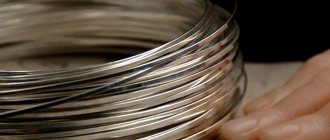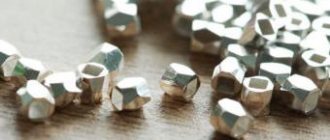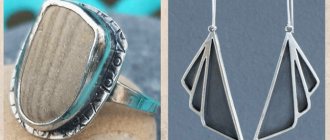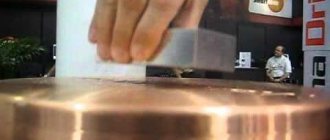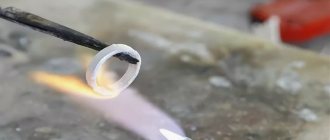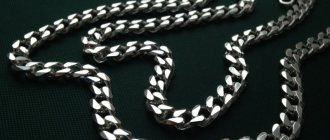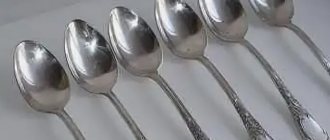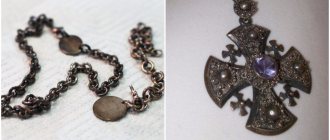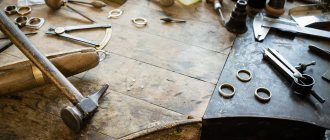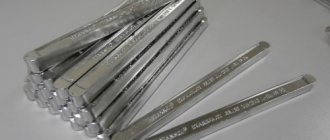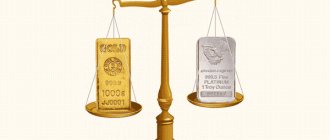Old Soviet radio components contain technical silver, which acts not as a precious metal, but as a technical metal.
High-quality technical silver is found in wires, batteries, contacts, and microcircuits. There is no definition for such a precious metal. We can say that technical silver is any silver that is used in radio engineering production.
How to remove silver from contacts: various ways to obtain the precious metal
Over the past decades, the rapid development of the electronics industry has led to a decrease in the use of precious metals in the production of components and semiconductors.
However, during the existence of the USSR, precious metals were one of the main and extremely important components of manufactured radio electronics.
There is a specialized reference book for the content of precious metals, from which you can find out the list of precious elements that make up a particular electronics component.
The most common noble metal in radio components is technical silver. It is pure metal with minor impurities or no impurities at all.
Thus, technical silver is almost always a high-grade metal of 999 purity. In this article we will tell you where it is found and how to remove this metal from the contacts and separate it from the copper at home.
Chemical properties of technical silver
The very concept of “technical silver” is used for secondary precious metal obtained by processing equipment, and for material used in technology.
The properties of lunar metal that have contributed to its widespread use are plasticity, high reflectivity, and increased chemical resistance. The metal does not react with oxygen, hydrogen, nitrogen, carbon, or silicon.
Technical silver melts at temperatures from 780 to 962 °C, boils at 2210 °C.
Where is this precious metal found?
For precious elements in electronics, properties such as thermal and electrical conductivity, as well as light reflection, play an important role.
Thus, noble metals are used in the following radio components:
- Microcircuits . The most promising options for metal mining are Soviet-made microcircuits. It is preferable to disassemble microcircuits of the 564, 530, 133, 134, 142, 155 and 1533 series.
- Capacitors . In addition to silver, palladium, platinum and gold can also be found here. The volume of certain metals depends on the type of case (ceramic, yellow, silver and tantalum), as well as on the year of manufacture of the devices. These components were used in various computers, electronic devices and automatic telephone exchanges, as well as in tube televisions and tape recorders.
- Resistors . The basis of these radio-electronic elements is silver. The most cost-effective components are resistors of the PTP, PPBL, PPML and 5K series. It is recommended to collect Soviet resistors produced before 1982. The key difference between this component is the diamond-shaped marking.
- Connectors . These devices, both Soviet and foreign made, are suitable for extracting silver, technical gold and other precious metals. However, the content of precious metals in foreign-made components will be approximately five times lower.
- Transistors . Another electronics component containing a relatively large number of noble elements. The most preferred for silver mining are transistors with the index 2T935A, 2T944A, 2T945A and 2T998A.
In addition to the above radio-electronic components, technical silver may be contained in:
- generator lamps;
- LEDs;
- switches;
- buttons.
List of silver-containing components in electronics
The main sources of silver recyclables for refining are radio and electrical devices. In addition to lunar metal, devices can contain gold, palladium, tantalum, and platinum.
Soviet microcircuits
The largest amount of silver plating is found on microcircuits manufactured before 1990.
If we compare these Soviet parts with others, they are quite promising for refining. The most lunar metal per 1000 units of microcircuits contains:
- 1200ЦЛ2 - about 120 grams;
- 1200TSL1 - about 114 grams;
- 1200M1 - about 90 grams;
- K57ZRF41/42 - about 70 grams;
Technical silver
Electronic machine capacitors
Capacitors can be found inside computing devices, tube televisions, tape recorders, and telephone exchanges.
A significant amount of precious metal per 1000 units of parts contain:
- ETO-4 600*10 - 14163.6999 grams;
- ETO-4 - 8345.16 grams;
- ETO-3 400*2 - 2450 grams;
- ETO-3 - 1655.07 grams;
The cost of one capacitor varies from 50 to 5000 rubles.
Radio resistors
The most valued are variable resistors whose copper terminals are treated with high-grade silver.
The prevailing amount of precious metal per 1000 units contains:
- UN-100 – 207 grams;
- UNU50 – 132 grams;
- UN 25 – 67 grams;
Resistors are among the most widely used elements in electronics.
Domestic and imported connectors
Connecting elements are used to temporarily connect electrical conductors using mechanical contact.
Imported connectors are less preferable for refining, since they are three times inferior in precious metal content to Soviet ones.
A lot of lunar metal can be obtained from connectors: RG1N-2–31 RG90–5 (socket) RMG-39B45Sh2A1 RG1N-2–23 RG1N-2–29.
Transistors
A transistor is a radio-electronic component made of semiconductor material used to amplify, generate, switch, and convert an electrical signal.
How to obtain silver from radio components at home?
Silver is a highly inert metal, which means that this element has weak reaction-chemical properties. In other words, it is not easily dissolved.
Under normal conditions, silver does not dissolve in hydrochloric and sulfuric acids, as well as in aqua regia , like gold.
However, this metal has good solubility in oxygen-containing nitric acid.
The answers to the questions of how to isolate, smelt or otherwise extract technical silver from radio components come down to three main methods :
- Mechanical processing is the simplest method, suitable for some types of contacts that can be easily separated using pliers and wire cutters.
- Heat treatment - in cases where it is not possible to extract silver mechanically, there is an option to resort to using a gas blowtorch. When the heat is high, the silver elements can be easily separated from the holder using available means.
- Treatment with nitric acid - this method is used to extract precious metals from massive parts of radio-electronic parts. The method requires high care and accuracy at each stage of processing.
Heat treatment
Smelting is suitable for extracting precious metal from silver contacts where the silver is soldered onto the contact holder.
The tools you need to use are a gas torch or cutter, as well as a knife with a wooden handle .
The principle of operation is to heat the silver contact and then remove it using a knife blade.
When the temperature is sufficient, the contacts can be easily removed from the holder.
Nitric acid treatment
This method is used to extract silver from massive parts of radio-electronic parts, for example, contacts of starters or automatic machines.
For processing you will need:
- quartz stick;
- glass container;
- 8% nitric acid solution;
- copper.
When working with any acids, the following rules must be observed :
- It is important to ensure constant ventilation; the best option is to carry out work in the fresh air;
- eyes should be protected with special glasses, and the skin of hands with rubber gloves;
- you need to pour acid into water, and not vice versa.
First, you need to dilute the nitric acid by mixing deionized water and acid in a 1:1 ratio.
The resulting liquid must be mixed with a quartz rod. The amount of diluted acid must be taken into account based on the calculation of 50 grams of silver per 1 liter of liquid.
After that, dissolve the silver in acid mixed with water. The dissolution process is quite long and will take from 8 to 10 hours .
Use of silver in electronics. Technical silver in the USSR
Silver conducts electricity and heat better than other metals. It is inert to water, air, and some gases. It is used in a wide variety of industries, the list of which is constantly expanding.
The precious metal is used to create jewelry, in the production of contacts for various electrical products, for minting coins, as a means of investment, in the production of mirrors, clothing, batteries, in the chemical industry, and photography. The volumes of lunar metal attributable to the industrial sector exceed 70% of global production.
Silver alloy wire
During the Soviet era, they did not skimp on silver in the production of radio components. The metal used in this area is called technical. This is a special alloy containing copper, nickel, tin, aluminum, cadmium as impurities. The number of additives is not large, usually does not exceed 0.2% of the total composition. The bulk of it is pure silver.
The exception is magnetic and non-magnetic samples of technical precious metals. Here the silver content varies from 60 to 80%.
If jewelry metal performs a decorative function, then technical metal must provide electrical conductivity and reflection of light.
Sales of the resulting metal raw materials and its average price per gram
For the subsequent sale of precious metal from contacts, you need to know its resulting mass and sample. As mentioned earlier, technical silver used in radio electronics is a pure metal of 999 purity.
Accordingly, metal obtained mechanically or by smelting will be 999 fine. If silver was extracted chemically using nitric acid, the output would be a metal of approximately 980 fineness. This is due to the copper impurities present in silver.
The direct cost will depend on two main factors :
- percentage of pure silver in the resulting alloy;
- places of sale of precious metals.
For 2022, the price for 1 gram of technical silver scrap is as follows :
- sample 999 – from 24 to 35 rubles;
- 980 – from 21 to 27 rubles;
- 960 – from 16 to 22 rubles;
- 925 – from 9 to 11 rubles.
When selling more than 1 kg of precious metal, you can earn 2-4 rubles more for each gram of it.
It is also most likely that on the Internet, using thematic sites and forums, you can find buyers who are ready to offer a higher price for those. silver from contacts than from a pawn shop.
Methods for separating silver from copper at home
Experts say that nowadays, silver (Ag) products are becoming increasingly popular. There are many reasons for this - the price, which is an order of magnitude lower than that of gold, practicality, and, of course, beauty.
Pure silver without impurities is very rare. The procedure for separating it from copper is becoming more and more popular, because it is quite rare to find products made from pure silver without impurities. The separation process is called refining, and it can even be done at home.
Silver contacts: how to remove?
Many people still keep radio components from the USSR era in their homes. They contain silver contacts that can be removed at home. To obtain precious metal, you will need to study the procedure and prepare special items.
What is the refining procedure?
It has long become popular to extract pure silver from alloys from which various parts and contacts are made. In order to obtain real pure precious metal at the output, you need to use a special separation technique called refining. It is thanks to it that you can separate silver particles from other metals, including copper.
Small silver bars for refining
Ideal for extracting pure silver:
- Scrap old silver jewelry;
- Waste from electrical cleaning of silver;
- Technological scrap, which contains silver;
- Waste from lead production, which is popularly called “silver foam”.
There are several ways to help separate Ag from other metals. The main ones are:
- cupellation;
- electrolytic method;
- chemical method.
The choice of method to be used depends on the volume of material, its composition and condition.
Safety precautions during refining
Before you begin the process of refining silver, at enterprises and at home , you must follow the mandatory precautions and safety instructions:
- good room ventilation;
- use of rubber gloves, special clothing and safety glasses;
- Working with nitric acid requires the use of a respirator. Nitrogen vapor is very poisonous;
- When mixing water and acid, you should never add water to concentrated acid, only vice versa.
Mistakes when refining silver
- Excessive amounts of nitric acid will lead to a bad reaction, the release of nitric oxide (" red tail ") in particular.
- The vertical arrangement of the electrodes one above the other when refining silver by electrolysis significantly weakens the effect of the electrolyte, and the silver is separated very slowly.
- During electrolysis, excess current can produce silver oxide, causing the precious metal to turn black.
- A fatal mistake is failure to follow safety rules when refining silver by any method. Inhalation of toxic chemical fumes, burns, etc. will not please the silver miner.
Electrolytic method
Another method that will help separate Ag from copper is electrolytic. To implement this, you will need cells made of plastic or sandstone containing a solution of silver nitrite.
The cathode is a strip of stainless steel on which silver is collected.
The amount of precious metal in the solution must be at least 50 grams per 1 liter of liquid. The contaminated silver itself acts as the anode of this reaction, and thin stainless strips act as the cathode.
Anodes, that is, contaminated silver, should be placed in small bags. It is in them that dirty metals will remain and will not dissolve during cleaning. Small crystals of pure silver will appear on the cathodes. They grow in the opposite direction to a short circuit and break very easily to avoid the same.
Such small crystals gradually break off and collect at the bottom in a special basket, from which they must be periodically removed. Pure silver ingots are smelted from the resulting crystals.
Cleaning silver from impurities
How to separate silver?
It has long been practiced to extract pure silver from contact alloys. To extract pure metal, special purification techniques called refining are required. This procedure is divided into several steps, the result of which is always the release of silver.
Although refining is an industrial procedure, you can solder the precious metal yourself at home. There are different ways.
Cupellation
Silver can be separated from low-grade alloys through cupellation. This method is based on the ability of molten silver and lead to begin to oxidize in air. With such contact, the metal will separate. To work, you will need a special furnace equipped with a bowl-shaped crucible. The bowl should have a marl coating based on porous limestone clay.
The process is divided into several stages:
- the oven is heating up;
- then an assay crucible is placed in it, which already contains technical silver and lead;
- heat the crucible until complete melting occurs;
- After this, air masses are released into the furnace.
The process includes a thermal reaction. When it runs out, you can remove the crucible and pour its contents into molds.
After cooling, the alloy takes on a rainbow color scheme. This indicates that, in addition to silver, it contains other precious metals.
Electrolytic method
To extract metal in this way, you will need special plastic or sandstone cells with silver nitrate. The precious metal content in the liquid is at least 50 g/liter. Contaminated silver will be used as the anode. The cathode in this situation is stainless steel, cut into strips of small thickness.
The anodes are placed in textile bags. These bags will then collect contaminated silver particles that were unable to dissolve. Silver macrocrystals will be deposited in the cathodes. They will grow towards the opposite pole until a short circuit occurs. To prevent a short circuit from happening, the branches of the crystals are broken during mixing of the solution . Such crystals independently settle to the bottom, from where they are removed. Ingots can be smelted directly from these components.
How the process itself works
Silver jewelry should be placed on a suitable surface that has low thermal conductivity and will not be destroyed by exposure to high temperatures, such as brick.
Then the place where the weld will be located needs to be coated with flux and a piece of solder placed there.
Now you can take the burner and smoothly move it towards the product. The treated area should warm up evenly. And as soon as the flux has completely melted, the heat must be increased and soldering continued until a truly reliable seam is formed.
If the solder and flux suddenly run out, you need to carefully add new portions of them to the same place.
Upon completion of soldering, the product must be cleaned of flux and solder residues. Sandpaper is suitable for solving this problem. Additionally, the surface of silver can be treated with a solution of citric acid for brightening or with an iodine solution for blackening.
Do not forget that soldering must be carried out in a ventilated area, and the person performing this operation must be protected by a mask or goggles
Sales of production
Do not forget that activities for processing scrap and waste of precious metals are subject to licensing in accordance with the legislation of the Russian Federation.
Individual entrepreneurs and legal entities have the right to buy and process the remains of precious metals if they have a certificate from the Assay Office.
If you try to sell metal that you yourself obtained from radio components to buyers, you should find out about criminal liability for illegal mining and sales.
Violations are regulated by Article 15.44 of the Code of Administrative Offenses, which states: the amount of the fine will be one or one and a half times the cost of the materials that are the subject of the offense.
Cost of various samples
The cost of any sample depends on the price of pure precious metal established by the Central Bank of the Russian Federation. To determine the current cost of the sample, you need to multiply the current price of the highest alloy by the required coefficient.
Current sample costs for 2022:
| Try | Cost per gram, rub. |
| 999 | 37 |
| 960 | 35,5 |
| 925 | 34 |
| 875 | 32 |
| 830 | 30 |
Silver from radio components usually has 999, 960, 875 standards.
Sales points
Buyers should be looked for on thematic forums and websites, among private advertisements. Pawn shops and purchases accept such metal several times cheaper than its real value.
If there is no license permitting the extraction of precious metal from recycled materials, you can try to make simple jewelry yourself from the resulting silver.
Chemical method
Materials needed: nitric acid 68.8%, deionized water, scales, glass container and quartz rod
For the separation itself, you will need hydrochloric and nitric acid. Before you begin, carefully inspect the copper and silver product. This could be a coin or wire, or a piece of jewelry. Determine whether the composition actually contains copper. This is quite simple to do, because everyone has long known that copper is not attracted by an ordinary magnet, but is an excellent conductor of electricity, so this is very easy to do at home using an ordinary magnet.
Dissolving silver in acid
Cupellation
If the silver content in the alloys is low, refining is carried out using cupellation
This method is most often used if low-grade alloys are used for cleaning.
The method is based on the unique properties of lead, melted with silver, to oxidize and independently separate from the silver, taking all impurities with it. But this does not apply to gold and platinum, which still remain alloyed with silver.
For cupellation, special furnaces are used with crucibles and covered with a special type of porous clay, which perfectly absorbs metal oxide.
Ag cupellation process sequence:
- Before the procedure, you need to preheat the oven, ensuring a temperature of 850-900°C;
The surface of the alloy acquires a rainbow color, and a silver sheen is also observed.
After the alloy has completely cooled, it will acquire a special rainbow color. This means that the alloy consists solely of silver and other precious metals.
Required materials and tools
In accordance with the descriptions of each of the individual methods of refining silver at home, we provide lists of materials and tools necessary for their implementation.
- Special cells made of sandstone or plastic.
- Nitric acid.
- Fabric bags.
- Sodium sulfite.
- Ammonium chloride.
- Salt.
- Nitric acid.
- Sulfuric acid.
- Special utensils, the material for which is selected depending on the components of the procedure.
The set of basic ones directly depends on which method of obtaining silver you have chosen.
So, to refining Argentum elements you will need:
- glass container;
- quartz stick;
- Nitric acid;
- ammonium chloride;
- salt;
- sodium sulfide;
- any filter;
- funnel;
- deionized water;
- copper scrap.
We invite you to familiarize yourself with Turquoise jewelry photos. When carrying out cupellation, you need to prepare:
To perform electrolysis you need:
- power unit;
- insulating material;
- stainless steel fork;
- insulating tape;
- tea bag bag;
- any plastic container.
Tools we will need
Many of the tools may already be available to DIY radio enthusiasts. Otherwise, you will have to purchase them or make them yourself from scrap materials.
Therefore, before unsoldering the radio component, get the following devices:
- A soldering iron of the required power and design for heating the contacts of radio components . You can take a ready-made one, or you can make it yourself; the manufacturing process is described in detail in the following article:
- Tweezers or clamp - used for manipulating radio components. Allows you to hold elements with tweezers, fix their position and provide additional heat removal when you try to desolder them.
- Tubular-shaped needles are sold ready-made, but if you don’t have any on hand, they can be replaced with a regular medical syringe needle, the main thing is that the inner diameter fits onto the stem of the radio component. In addition to needles, you can use tubes or sleeves; with their help, heated radio components are separated from the solder.
Rice. 1. Set of soldering needles
- Dismantling braid also acts as an auxiliary tool if you need to desolder those elements that have a large number of legs on the printed circuit board. You can either purchase a ready-made one or make it yourself.
Rice. 2: dismantling braid
- A desoldering pump is a device for removing solder from a mounting location, allowing you to quickly desolder a large number of radio components. Structurally, it includes a vacuum flask, a return spring and a piston driven by it. In addition to purchasing a factory model, you can make a desoldering pump yourself.
Rice.
3. Desoldering pump Inexperienced electricians may argue that so many tools for desoldering radio components will be too many. After all, soldering is performed using a regular soldering iron, but all of the above devices will help you solder the necessary elements quickly and accurately. This is especially true with large volumes of contact pins in the board. Now let's look at the practical application of each of the tools described above. Source
